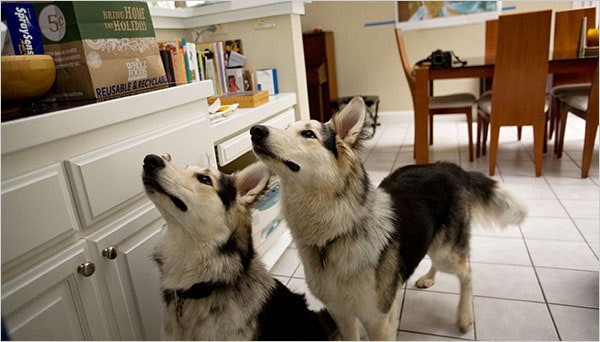Animal cloning…
You have probably come across this term at some point in your life.
The world was introduced to it in 1996 when Dolly the lamb was created in the laboratory by The Roslin Institute team of scientists and researchers. Dolly came out as a replica of another sheep.
Out of 277 attempts carried out during the cloning process, only the adorable white-faced Dolly managed to live to adulthood. This opened up a new world of possibilities for duplicating animals.
As a loyal and affectionate pet, a dog brings so much joy into the life of an individual or family.
Sadly, canines have incredibly short life spans. They pass away sooner than we expect.
The thought of saying goodbye forever can be overwhelming to think about.
Due to this, some pet parents opt to have a genetic twin of their lovely pets just so that they can keep them for a while longer.
If you are wondering what dog cloning is about, we have a detailed guide for you here.
We will tell you whether cloning is morally right or wrong, how the practice is carried out, whether it produces healthy (or otherwise) dogs among other FAQs.
What Is Dog Cloning?

The term cloning simply refers to the process of creating a genetic twin of an existing animal.
The cloned animal is born at a later date and will have the appearance and sometimes temperament of the original copy.
In the case of a dog, scientists will extract the genetic material of the original canine and infuse it into the cloned dog.
The process of cloning starts with the harvesting of cultured cells from the original pooch.
Experts extract viable cells from any part of the dog and take them to the laboratory.
The next step is the extraction of unfertilized eggs from random unrelated dogs.
The eggs are extracted from their fallopian tubes in an invasive but harmless procedure.
Often, scientists have to extract eggs from as many dogs as possible to increase their odds of success.
Once the eggs have been harvested, things get a little complex.
Each will have to be separated from the nucleus. Think of it as removing the yolk from the egg whites only on a small scale.
Scientists use a fine pipette to suck the nucleus out—a step that removes the genetic material of the egg.
In some instances, a targeted blast of UV light is used to destroy the genetic material in the nucleus. Either way, the eggs remain blank with no DNA in them.
The blank space is where the previously harvested cells of the original dog are placed.
Experts proceed to insert the genetic material in there to create a totally new DNA. They use a fine needle to insert the cells.
A composite egg alongside an electric burst fuses both the egg and cells together.
Just like that, the DNA of the original dog has been created. Cell division kicks off and continues for a few days.
After cell division, scientists will implant the cells into another dog—the surrogate.
Surrogates are treated with hormones to make them viable to carry the pregnancy to term.
To increase the chance of success, surgeons will implant the cells in many surrogate dogs.
Many of them don’t take hold, others miscarry, and others give birth to puppies with defects. Only a few make it to the end and give birth to good healthy puppies.
Has a dog been successfully cloned?
Although cloning of livestock kicked off in 1996, it wasn’t until 2005 that a dog was successfully cloned.
The doggie—an Afghan Hound by the name of Snuppy—emerged after 1095 embryos were implanted into 12 dogs.
Snuppy gained TIME Magazine’s title of “Invention of the Year” and the news of his creation spread like bushfire.
Not only did he live a healthy life for 10 years but he went ahead and fathered puppies of his own.
Although the making of Snuppy was rather complex, time-consuming, and intense, the process has since been pared down.
Over the next couple of years, cloning of dogs went from being a reserve of the high and mighty to being accessible to all.
As long as your pockets are deep, you can have your pets cloned.
The famous filmmaker and singer Barbra Streisand also had her Cotton De Tulear Samantha cloned.
She spoke to Variety in 2018 claiming that out of her three identical dogs, two of them came from the cloning of Samantha.
At the time, Samantha had passed away and she was now left with Miss Violet and Miss Scarlet.
Amy Vangemert’s cloned dogs Buhner Junior and Ditto also created a buzz in 2017.
When her original dog, Buhner, started aging, Amy could not imagine a world without him.
She came across pet cloning and decided to give it a try. The price shocked Amy and her spouse at first ($50,000) but they soon determined it was worth it.
Now they own Buhner, his two clones Buhner Junior and Ditto, and another doggie by the name of Bella.
We could go on and on but the bottom line is that many dogs have been successfully cloned in the past. These are just a few samples from the pool.
Are cloned dogs similar to their donors?

Many pet parents who follow dog cloning do so to get the exact copy of their dogs in terms of looks, character, intelligence, affectionate nature, and all.
Sadly, many end up with a dog with a different temperament.
See, while cloned Fidos have the same genes as their donors, the genes express a bit differently.
It is not unusual for the coat or eye color to differ from that of the original dog.
Personality also differs greatly. This is mainly because the character of your dog is based on the environment the puppy is born and raised in.
The training of the dog also plays a key role in shaping its temperament.
No matter how careful the scientists are at the lab, they cannot replicate personality.
Can you clone a dog from ashes?
Not really. Cloning requires viable cells from the donor dog.
The kind of heat cremation chambers emit destroys any living cells in your dog.
No genetic material is left after the process is complete.
According to Radiant Heart, the temperature in commercial pet crematoriums is around 16500F.
DNA has a carbon-based structure. If you remember your Chemistry 101, such molecules are easily burnt in such high temperatures.
Cremation essentially burns through any organic matter for health reasons. What’s left is ashes and nothing else.
Can you clone a dog from hair?

Human hair carries a genetic code no wonder DNA analysis can be extracted from one strand.
However, it is not the same case for dog hair.
According to PubMed, one strand of dog hair contains trace amounts of DNA material.
Broken strands or those with roots are the worst as they have bad quality cells.
With that said, a large sample of dog hair can be used to extract some DNA.
Cloning, on the other hand, is difficult using dog hair. For cloning to happen, the cells extracted must be complete and somatic.
Unfortunately, bones, bloodstain, scurf, hair, and saliva don’t have active somatic cells.
Can you clone a dead dog?

Singer Streisand’s cloned dogs were created after Samantha had passed away. These are just living examples that a dead dog can produce living cells used in cloning.
Even after the animal is dead, scientists can quickly extract live cells before bacteria destroy them.
Keep in mind, however, that not all dead dogs have live cells in their bodies.
After death, the immune system takes a rest. As a result, microorganisms in the body feast on the remains. And they do it fast. This can take less than a day.
If you want your pet cloned after death, it is in your best interest to call the cloning facility to harvest DNA material as early as possible.
If they cannot be there soon enough, wrap the pet in a damp towel and place it in a refrigerator, not the freezer.
This slows down the action of microorganisms and buys you some time.
Generally, a refrigerated dog has live cells for up to a week after death.
After that, the cells in the material cannot be feasible for cloning. Remember that freezing destroys the cells altogether.
Is it legal to clone a dog?
In the United States, the United Kingdom, South Korea, and many first-world countries, pet cloning is legal.
If you have the financial muscle, no one will stop you from creating longer lifespan for your pets.
It is just unethically wrong—at least for many people.
How long do cloned dogs live?

Where FDA is concerned, cloned animals such as sheep, pigs, and goats are healthy, for the most part.
As long as they are normal at birth, they grow up to be strong and healthy like other animals.
With that said, it is hard to predict what really happens down the road. For instance, the first animal to be cloned—Dolly the sheep—lived half the age of her donor.
Snuppy, the Afghan Hound, enjoyed a healthy life and a long lifespan of 10 years (Afghan Hounds live to be 11 years old).
The conclusion is that cloning doesn’t affect the health and lifespan of a dog much.
What the animal is exposed to is much more important. If you feed your cloned dog a poor diet, fail to exercise him, or take him for medical checks, he will not live as long as other dogs from the breed.
How much does it cost to clone a dog in 2021?
It depends on the cloning company in question.
One of the renowned companies, Texas-based ViaGenPets charges $50,000 to clone one dog. The amount is paid in two equal installments.
The second famous cloning facility is South Korea’s Sooam Biotech whose fee is $100,000.
Clearly, cloning is not for everyone. Only the wealthy can afford it for now.
Is cloning pets good or bad?

Like most things in life, pet cloning has its proponents and opponents.
Those that are for it claim that the practice elongates their relationships with their dogs.
On the other hand, the opponents have a long list of reasons why cloning is a vice.
According to this group, no one has the right to bioengineer a copy dog, so to say. Only Mother Nature gets to make that decision.
Morally, pet cloning is bad as it harms many animals in the process.
A dozen or more embryos have to be harvested from one dog. Sometimes this means having her mate a fixed male dog to get her eggs ready for harvesting.
Then there’s the fact that many surrogates have to take part to boost the chance of success. All these animals deserve better than that.
Finally, cloning also gives rise to many puppies with birth defects. Many of them have to be euthanized later else they live miserable lives.
Our Verdict
From our end, we strongly oppose cloning of dogs for the reasons mentioned above.
The sheer number of animals that undergo procedures is saddening.
Keep in mind that these are invasive surgeries. The donors have to take hormonal treatments and take part in the actual egg harvesting.
Likewise, surrogates receive many rounds of hormones to ready them for implantation and gestation.
The saddest part is killing the puppies born with birth defects.
Even after cloning, there’s no guarantee that you will have the same pet.
We’ve mentioned that personality changes are to be expected. Don’t be surprised if your cloned friend turns out to be the exact opposite of your original doggie.
To save yourself, get a new dog and work the journey of creating a new relationship with them.
You will realize that you have the capacity to fall madly in love with another doggie.
Closing Thoughts
There it is – a quick guide of what cloning of dogs is.
The truth is that you can clone your dog but should you do it?
If you are passionate about animals, you can already see that this practice is just not fair for our furry friends.
Choose wisely!
As an Amazon Associate, we may receive a small commission from qualifying purchases but at no extra cost to you. Learn more. Amazon and the Amazon logo are trademarks of Amazon.com, Inc, or its affiliates.


